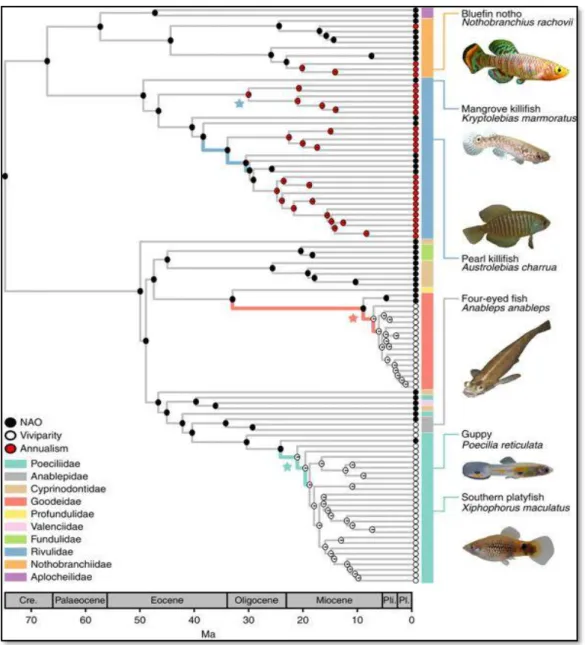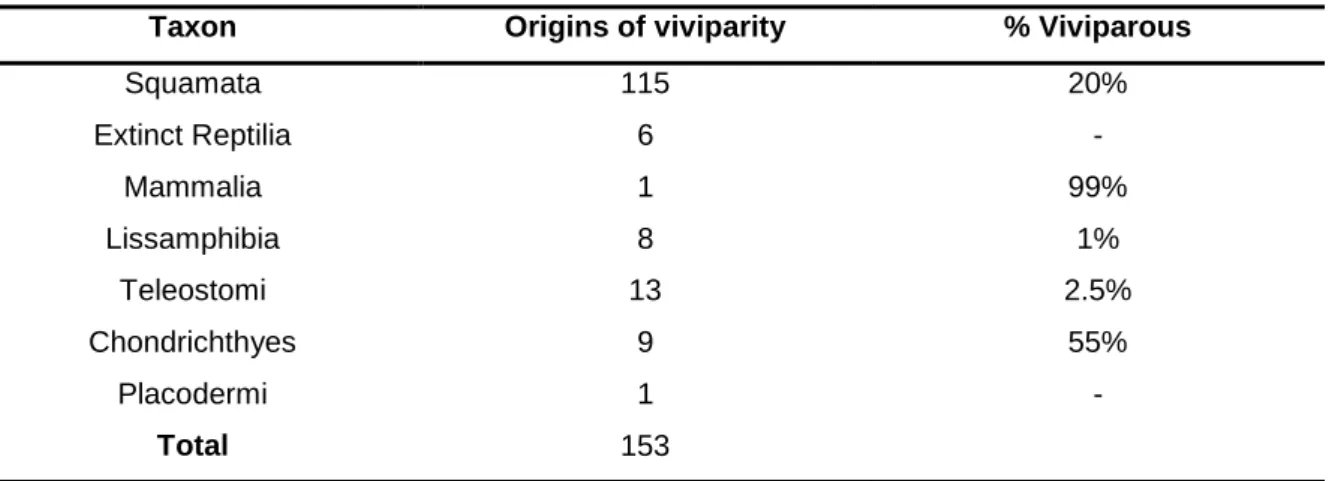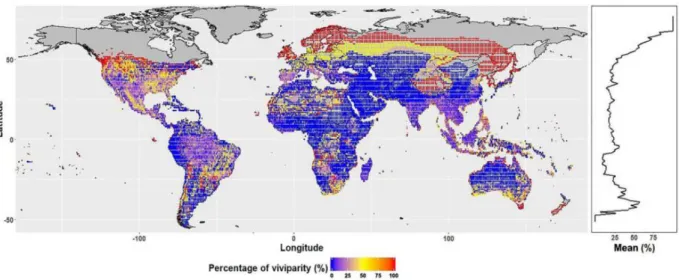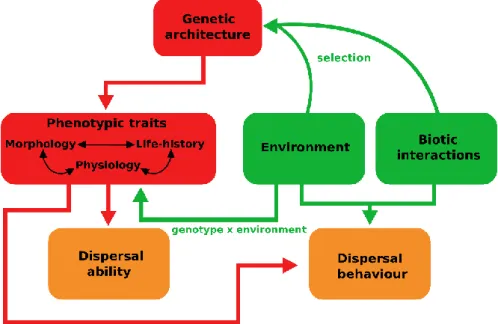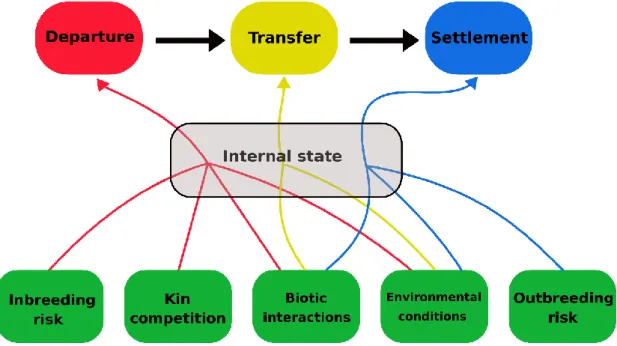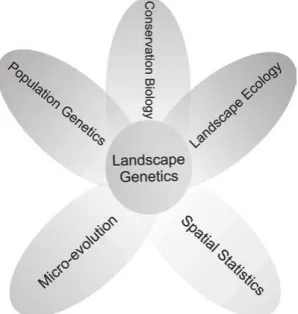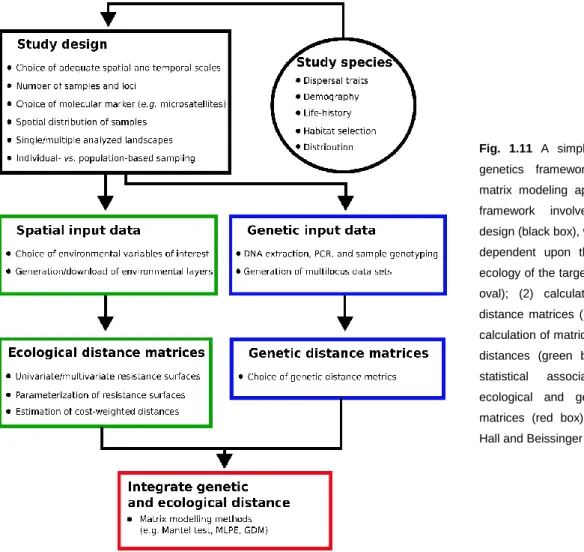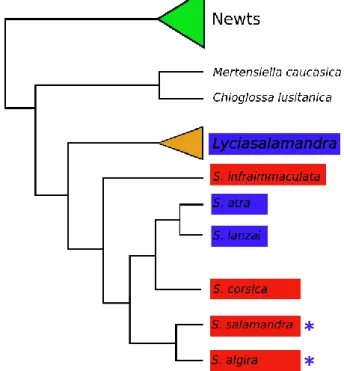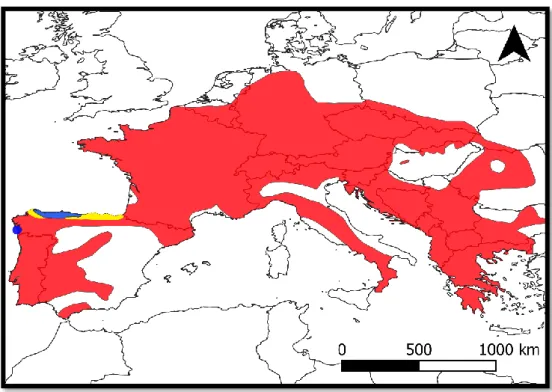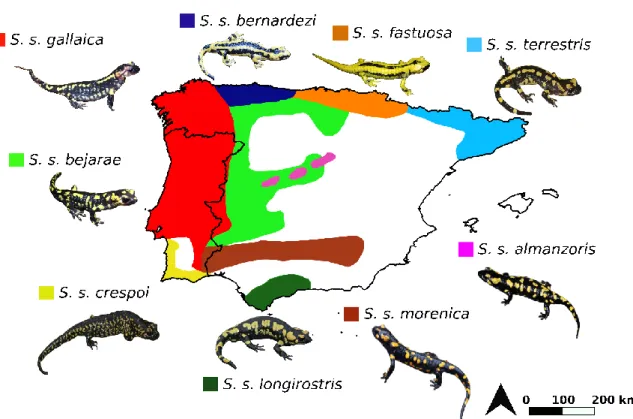D
Eco-evolutionary
implications
underlying the
emergence of a
derived reproductive
mode in fire
salamanders
André Filipe Plácido Lourenço
Biodiversity, Genetics, and Evolution
Department of Biology 2019
Orientador
Guillermo Velo-Antón, Auxiliary Researcher, CIBIO-InBIO/FCUP
Coorientador
Nota prévia
Na elaboração desta tese, e nos termos do número 2 do Artigo 4º do Regulamento Geral dos Terceiros Ciclos de Estudos da Universidade do Porto e do Artigo 31º do D.L. 74/2006, de 24 de Março, com a nova redação introduzida pelo D.L. 230/2009, de 14 de Setembro, foi efetuado o aproveitamento total de um conjunto coerente de trabalhos de investigação já publicados em revistas internacionais indexadas e com arbitragem científica, os quais integram alguns dos capítulos da presente tese. Tendo em conta que os referidos trabalhos foram realizados com a colaboração de outros autores, o candidato esclarece que, em todos eles, participou ativamente na sua conceção, na obtenção e análise de dados, e discussão de resultados, bem como na elaboração da sua forma publicada.
Este trabalho foi apoiado pela Fundação para a Ciência e Tecnologia (FCT) através da atribuição da bolsa de doutoramento (PD/BD/106060/ 2015).
Agradecimentos
A conclusão desta tese não teria sido possível sem a ajuda de várias pessoas, desde colegas de profissão até familiares e amigos. Algumas instituições também forneceram suporte (especialmente financeiro) que foi crucial para desenvolver todo o trabalho de campo e laboratorial incluído na presente tese doutoral.
Contrariando o formato habitual da secção de “Agradecimentos” em teses doutorais, as minhas primeiras palavras de agradecimento vão para os meus pais. Eles são os principais responsáveis por ter chegado a este ponto profissional da minha carreira. Eles deram-me amor, educação, conselhos de vida bastante importantes e não menos importante, apoiaram sempre as minhas decisões profissionais, mesmo sabendo que a área de investigação (e em particular da Biologia) acarretam alguns riscos. Por isto tudo, eles merecem este agradecimento especial. Espero um dia retribuir um centésimo daquilo que eles fizeram pela minha vida.
Em seguida, um agradecimento muito especial para o meu orientador principal, Guillermo Velo Antón. Ele ajudou-me a planear o meu doutoramento, demonstrou uma grande disponibilidade para discutir ideias sobre o meu trabalho, ajudou-me no meu trabalho de campo, reviu com bastante rapidez os incontáveis drafts de artigos e propostas de financiamento que enviei, esteve disponível para falar sobre temas de índole pessoal e foi um grande companheiro para beber cervejas. Por outras palavras, ele foi aquilo que, na minha perspectiva, deve de ser um orientador de doutoramento. Sem ele, jamais esta tese tería sido possível e portanto um “muchas gracías” a ti Guillermo. Continua a ser o investigador que és e mais tarde ou mais cedo irão dar-te o devido valor em Portugal, Espanha ou noutro lado qualquer.
I also have to thank my co-supervisor Ian Wang, who accepted me as his PhD student, kindly hosted my short-term stayings at University of California, Berkeley, and provided insightful opinions about the experimental design of my thesis and my manuscripts. Your teachings greatly helped me improve as a researcher.
Agradeço também às instituições de financiamento, nomeadamente, a Fundação para a Ciência e Tecnologia (FCT). A FCT não só forneceu financiamento individual (bolsa de doutoramento - PD/BD/106060/2015), mas também forneceu financiamento para suportar o meu trabalho de campo e laboratorial (EVOVIV: PTDC/BIA-EVF/3036/2012; SALOMICS: PTDC/BIA-EVL/28475/2017). Finalmente, também agradeço a outras instituições/programas que financiaram o meu trabalho, nomeadamente, aos fundos europeus do programa operacional de competitividade (FEDER; FCOMP-01-0124-FEDER-028325 and
POCI-01-0145-FEDER-006821) e também à British Herpetological Society que me ofereceu uma bolsa de Student Grant Scheme para financiar o meu trabalho de campo.
Esta tese também não teria sido terminada sem as instituições que me acolheram, nomedamente, o Centro de Investigação em Biodiversidade, Genética e Evolução (CIBIO-InBIO) da Universidade do Porto que forneceu as condições logistícas indispensáveis (gabinete, laboratórios e viaturas para realizar o trabalho de campo) ao término desta tese. Também agradeço ao polo universitário de Berkeley da Universidade da Califórnia por terem-me recebido.
Um muito obrigado também para os co-autores dos meus artigos – David Álvarez, Bernardo Antunes, João Gonçalves e Filipe Carvalho. Sem a vossa ajuda, os meus manuscritos teriam menos qualidade cientifíca. Agradeço também às pessoas que ajudaram na minha amostragem, uma vez que estiveram dispostas a dispender o seu tempo para ajudar a completar o meu doutoramento. Essas pessoas são: o Bernardo Antunes, Marco Dinis, Bárbara Santos, Clara Figueiredo Vásquez, Fábio Sousa, Lucía Ríos, Margarida Henrique, Aspassia Anagnostopoulou, Alessio Paoletti, Pedro Alves, Paulo Pereira, Sophia Rosa e Iria Pazos.
Também quero agradecer às pessoas que trabalham no Centro de Testagem Molecular (CTM) que tiveram muita paciência para aturar-me e demonstraram uma grande disponibilidade para ajudar e tirar as minhas dúvidas. Agradeço em especial à Susana Lopes pela ajuda na genotipagem dos microsatélites, à Patrícia Ribeiro e Sofia Mourão pela ajuda no laboratório e à Sara João pelo apoio logístico em relação ao material laboratorial. E como não podia deixar de ser, agradeço ao “rei” do CIBIO, o Sr. Bernardino, pelos transportes metro-Vairão, por resolver todos os problemas que ocorrem no CIBIO e, acima de tudo, pelo companheirismo.
Em seguida, gostaria de agradecer aos “miguxos” e “miguxas” pelos momentos de convivío, companheirismo, aconselhamento, bubadeiras, etc… Em especial gostaria de agradecer à Damas, Rita Monteiro, Pleno, Coelho, Jesus, Joana Amaral, Diana, Joana texugo, Joana Guimarães, Paulo, Hugo, Jessica, o bácaro do Passinhas, o porco do Duarte, o Luzpalo, Inês, João Gil, Ana Serrano, Cristina, Nádia, à Piranha, o Calistro, o Fainha e mais umas quantas pessoas (para salvaguardar caso me tenha esquecido de alguém). Vocês sabem que são batsante importantes na minha vida e por isso um muito obrigado especial a vocês todos!
Como não podia deixar de ser, a minha família é um pilar muito importante da minha vida. Agradeço aos meus familiares pela ajuda e por todos os momentos de convivío que permitiram-me relaxar e assim, encarar esta tese de uma maneira muito mais eficiente. Um
agradecimento especial à minha irmã Nela e aos “pigs” Zé e Francisco pelos momentos de parvoíce, entre outras coisas.
Finalmente, um MUITO OBRIGADO por tudo à minha bolachinha Barbara Correia. Obrigado não só pelo papel ativo que tiveste na concepção desta tese (ajudar-me no trabalho de campo, ler os meus incríveis drafts de artigos, emprestares-me o carro para trabalho de campo, etc…), mas também pelos momentos de preguiça no sofá, pelo apoio e carinho inestimáveis, pela compreensão ilimitada, pela (quase) inesgotável boa disposição para as minhas totozices e pelas aventuras partilhadas e por aquelas que irão ser partilhadas. Ah e claro, obrigado pelo Golias (ele agora é meu!). Espero poder continuar a partilhar esta viagem a que chamam “vida” contigo para sempre.
Resumo
A transição de um modo reprodutor ancestral ovíparo para um modo derivado vivíparo constitui uma grande inovação evolutiva que ocorreu várias vezes de forma independente em vertebrados em resposta a fortes pressões seletivas na descendência (ex: predação ou condições ambientais extremas). Estas mudanças nas estratégias reprodutoras causaram alterações profundas a nível fenotípico, ecológico e genético. A maior parte dos estudos que examinaram os efeitos das alterações nos modos reprodutores focaram-se nas mudanças fenotípicas e genéticas decorrentes da evolução de um modo reprodutor derivado, em particular, nos répteis. Os efeitos de um novo modo reprodutor na ecologia dos indivíduos e, por conseguinte, na evolução das populações, têm recebido pouca atenção pela comunidade científica, embora alguns estudos tenham explorado algumas das consequências eco-evolutivas subjacentes a um modo reprodutor derivado (ex: taxas de sobrevivência e colonização de ambientes instáveis mais elevada, mudanças na evolução de caracteres fenotípicos e nas taxas de diversificação de espécies). Um processo determinante para a dinâmica populacional e que está altamente correlacionado com a reprodução é a dispersão (e o fluxo génico). Considerando isto, as alterações biológicas e comportamentais subjacentes à reprodução podem modificar a maneira como os indivíduos dispersam pela paisagem, o que pode ter consequências para a conetividade genética. Apesar do possível efeito de alterações nos modos reprodutores na dispersão, este assunto tem sido muito pouco explorado.
As transições para o viviparismo ou pueriparismo (o último conceito é mais correto para anfíbios) causaram mudanças significativas no ciclo de vida dos anfíbios, o que faz deles bons sistemas para investigar os efeitos eco-evolutivos decorrentes de uma alteração no modo reprodutor. A maior parte dos anfíbios exibe um ciclo de vida bifásico, em que um estágio larvar aquático é seguido por uma metamorfose para juvenis terrestres. No entanto, alguns anfíbios mudaram de uma reprodução aquática ovípara ou larvípara (deposição de ovos ou larvas na água, respetivamente) para uma reprodução terrestre puerípara (parturição de juvenis terrestres), possivelmente em resposta à escassez de corpos aquáticos nos seus habitats para depositar a descendência. Esta maior independência da água pode ter envolvido mudanças substanciais na ecologia e evolução de populações pueríparas quando comparado com populações de anfíbios aquáticos. Por exemplo, pode-se esperar que anfíbios pueríparos dispersem por maiores distâncias devido à sua menor dependência de corpos de água para a reprodução.
Na presente tese doutoral, eu usei marcadores moleculares (maioritariamente microsatélites) para availar as implicações eco-evolutivas potenciais que resultaram de uma mudança de uma reprodução aquática para uma reprodução puerípara terrestre em anfíbios, com especial destaque para a dispersão e o fluxo génico. Eu usei como modelo de estudo a salamandra-de-pintas-amarelas (Salamandra salamandra, Linnaeus 1758), que constitui um excecional e raro caso em que duas estratégias de reprodução co-ocorrem: (i) reprodução aquática larvípara (caracter ancestral), em que as fêmeas depositam larvas em corpos de água; e (ii) um modo de reprodução terrestre pueríparo, em que as fêmeas dão à luz juvenis terrestres metamorfoseados. O pueriparismo surgiu em S. salamandra durante o período do Plioceno-Pleistoceno na cordilheira Cantábrica (norte de Espanha), possivelmente, em resposta à escassez de água superficial em substratos cársticos calcários. Esta variação nas estratégias reprodutoras ao nível subespecífico permite fazer comparações robustas entre modos reprodutores, uma vez que esse tipo de comparações diminuem o efeito de um possível enviasamento causado por elevadas diferenças a nível fenotípico e ecológico commumente observadas em espécies muito divergentes a nível filogenético. Nesta tese, populações larvíparas de S. s. gallaica e populações pueríparas de S. s. bernardezi, localizadas no norte de Espanha, foram estudadas para abordar o meu objetivo principal.
O pueriparismo permitiu a sobrevivência de anfíbios em ambientes aonde a água é um recurso limitante (ex: substratos calcários, terrenos íngremes). No entanto, no capítulo 2, eu introduzo um caso de estudo que mostra perfeitamente que o pueriparismo também permite maiores taxas de sobrevivência num cenário de alterações contemporâneas da paisagem (urbanização). Em específico, eu analisei os padrões de variação genética em populações pueríparas e urbanas de S. salamandra na cidade histórica de Oviedo (Espanha). Estas populações encontram-se espalhadas pela cidade em pequenas parcelas de vegetação (ex: parques e jardins urbanos) e, algumas delas, têm persistido dentro dos limites da cidade por centenas de gerações. A sobrevivência a longo prazo destas populações só foi possível graças à sua reprodução puerípara, uma vez que estas parcelas urbanas não têm água para o desenvolvimento de larvas. Análises genéticas revelaram que a maior parte das populações estudadas têm um tamanho populacional baixo (Ne < 50) e que estão altamente isoladas a nível genético, apesar de a diversidade genética ser relativamente alta. O pueriparismo, assim como outros mecanismos demográficos e genéticos, foram sugeridos como potenciais causas destes níveis de diversidade. Para além disto, a compreensão dos fatores que influenciam a deriva genética nas cidades é fundamental para prever a direção e a magnitude das alterações evolutivas nas espécies que habitam ambientes urbanos. Considerando isto, as populações de salamandras-de-pintas-amarelas analisadas em Oviedo constitutem um bom sistema para
examinar este tópico. Eu testei no total quatro variáveis independentes (tamanho da parcela, tempo desde isolamento, magnitude de bottleneck e tempo pós-bottleneck) e as análises de regressão demonstraram inequivocamente que o tamanho da parcela está positivamente associado com o Ne e, consequentemente, com a variação genética neutral em ambientes urbanos.
Os capítulos 3 e 4 foram dedicados ao estudo dos efeitos potenciais do pueriparismo na dispersão e conetividade genética. Dado que a dispersão e o fluxo génico estão intimamente associados com a distribuição de corpos de água para a reprodução em anfíbios, então eu hipotetizei que a evolução de uma reprodução terrestre puerípara em salamandras-de-pintas-amarelas fosse acompanhada por mudanças nestes processos. No capítulo 3, eu usei métodos genéticos de autocorrelação espacial para avaliar se o pueriparismo causou diferenças significativas nos padrões de estrutura genética e dispersão a escalas locais (transetos de 1 km). Os resultados deste capítulo sugerem que os padrões de dispersão (i.e. comportamento de dispersão) são semelhantes entre os modos reprodutores e que os machos dispersam mais que as fêmeas em S. salamandra, embora dados adicionais sejam necessários para confirmar estes resultados. Além disto, dados recolhidos nos capítulos 3 e 4 demonstram que sistemas lóticos são largamente responsáveis por assimetrias na dispersão entre salamandras larvíparas e pueríparas. Análises de parentesco (capítulo 3) sugerem que dispersão mediada pela água pode promover eventos de longa dispersão durante a fase larvar aquática, podendo assim, aumentar as distâncias percorridas pelos indivíduos durante a sua vida. Para além disto, análises da genética da paisagem feitas no capítulo 4 demonstram inequivocamente que rios e ribeiras reduzem a conetividade genética apenas em populações pueríparas, muito provavelmente porque as salamandras pueríparas exibem um ciclo de vida totalmente terrestre. Este efeito não foi documentado em populações larvíparas, uma vez que indivíduos larvíparos provavelmente atravessam estes elementos aquáticos durante a fase larvar aquática. Finalmente, as análises da genética da paisagem feitas no capítulo 4 contribuiram com informação importante para a ecologia da paisagem desta espécie. Especificamente, estas análises revelaram que áreas agrícolas e, em menor grau, exposição ao vento e topografia, são importantes variáveis que explicam a diferenciação genética em populações larvíparas e pueríparas.
Em conclusão, esta tese doutoral contribuiu para uma melhor compreensão das implicações eco-evolutivas resultantes de uma mudança de uma estratégia aquática de reprodução (larviparismo) para uma estratégia terrestre (pueriparismo) em anfíbios. Para além disto, alguns tópicos pouco explorados sobre a ecologia e a evolução de S. salamandra foram também abordados nesta tese e os resultos obtidos podem ajudar futuros estudos focados
em aspectos ecológicos, evolutivos e de conservação relevantes para esta espécie e para outras também. Esta tese também aponta para futuras direções de investigação que podem eventualmente contribuir para um maior conhecimento dos efeitos ecológicos e evolutivos das transições nos modos reprodutores.
Palavras-chave: dispersão, estrutura genética, fluxo génico, genética da paisagem, genética
de ambientes urbanos, larviparismo, microsatélites, Ne, população, pueriparismo,
Summary
The transition from an ancestral oviparous (egg-laying) to a derived viviparous (live-bearing) reproduction comprises a major vertebrate innovation that has occurred independently multiple times across vertebrates in response to strong selective pressures on offspring (e.g. predation and stressful environmental conditions). These changes in reproductive strategies caused profound phenotypic, ecological, and genetic alterations. Most studies examining the effects of shifts in reproductive modes have focused on the phenotypic and genetic alterations caused by the evolution of a derived reproductive mode, particularly, in reptiles. The effects of a novel reproductive mode on the ecology of individuals and, by extension, in the evolution of populations has received much less attention, although a few studies have explored some of the potential eco-evolutionary consequences underlying derived reproductive traits (e.g. higher colonization and survival rates in harsh environments, changes in phenotypic evolution and species diversification rates). One process that plays a crucial role in population dynamics and is intimately correlated with reproduction is dispersal (and gene flow). Hence, changes in reproductive biology and behaviour are expected to alter the way individuals disperse across the landscape, with potential consequences to successful reproduction (e.g. genetic connectivity), though this subject has been even more underexplored.
Transitions to a viviparous or pueriparous (the latter term is more accurate for amphibians) reproduction caused significant life-history alterations in amphibians, making them good systems in which to examine the eco-evolutionary effects of changes in reproductive modes. Most amphibians exhibit a biphasic life cycle in which an aquatic larval stage is followed by metamorphosis into terrestrial juveniles. However, some amphibians shifted from ancestral oviparous or larviparous aquatic reproduction (delivery of eggs or larvae in water, respectively) to a pueriparous terrestrial reproduction (parturition of terrestrial juveniles), possibly in response to a lack of suitable water bodies in their environments for depositing offspring. This greater independence from water may entail substantial changes in the ecology and evolution of pueriparous populations compared to their ancestral aquatic-breeding counterparts. For example, one can expect that pueriparous amphibians disperse farther across the landscape due to their lower dependence from water bodies suitable for breeding.
In the present thesis, I relied on molecular markers (mostly microsatellites) to evaluate some of the potential eco-evolutionary implications arising from the shift of an aquatic reproduction to a pueriparous terrestrial one in amphibians, with a special emphasis on dispersal and gene flow. I used as a model system the fire salamander (Salamandra salamandra, Linnaeus 1758), which constitutes an exceptional and rare case, with two distinct reproductive strategies
co-occurring: (i) an aquatic larviparous reproduction (the ancestral trait), in which females deliver larvae in water bodies; and (ii) a terrestrial pueriparous reproduction (derived trait), in which females deliver fully metamorphosed terrestrial juveniles. Pueriparity emerged in S.
salamandra during the Pliocene-Pleistocene period in the Cantabrian mountains (northern
Spain), possibly, in response to the lack of surface water in karstic limestone substrates. This variation in reproductive strategies within species allows robust comparisons between reproductive modes, as it decreases the potential effects of confounding factors, such as the high phenotypic and ecological dissimilarity commonly observed in distantly-related species. In this thesis, larviparous populations of S. s. gallaica and pueriparous populations of S. s.
bernardezi located in northern Spain were studied to address the main goal.
Pueriparity enabled the survival of amphibians in natural water-limited environments (e.g. karstic limestone substrates, steep terrains), but in chapter 2, I present a case study which neatly shows this reproductive mode may also entail higher survival rates under a scenario of contemporary land cover changes (urbanized landscapes). Specifically, I assessed patterns of genetic variation in urban pueriparous populations of S. salamandra in the historical city of Oviedo (Spain). These populations inhabit small patches of vegetation (e.g. urban parks and gardens) scattered across the city, some of which have putatively persisted for hundreds of generations. This long-term persistence was only possible due to their pueriparous reproduction, as these patches lack surface water for the development of larvae. Genetic analyses revealed most studied populations are small (Ne < 50) and genetically isolated to a large extent, although genetic diversity is relatively elevated. Pueriparity, as well as other potential demographic and genetic mechanisms, were suggested as potential drivers of these diversity levels. Moreover, understanding the factors governing genetic drift in cities is key to better predict the direction and magnitude of evolutionary changes in urbanized landscapes. In this regard, the fire salamander populations studied in Oviedo also comprise a good system to examine this topic. I tested four predictors in total (patch size, time since isolation, bottleneck magnitude, and post-bottleneck time), and regression analyses clearly indicate patch size is positively associated with Ne and, consequently, with neutral genetic variation in urban settlements.
The following chapters 3 and 4 were dedicated to the study of the putative effects of pueriparity on dispersal and genetic connectivity. Given that dispersal and gene flow are intimately associated with the distribution of water bodies for breeding in amphibians, I expected the evolution of a terrestrial pueriparous reproduction in fire salamanders was accompanied by changes in these processes. In chapter 3, I employed a genetic spatial autocorrelation framework to evaluate whether pueriparity caused significant differences in
patterns of fine-scale genetic structure and dispersal at local scales (1-km transects) between reproductive modes and sexes. Results suggest that dispersal tendencies (i.e. dispersal behaviour) are similar between reproductive modes and that dispersal in S. salamandra is male-biased, although additional data is required to properly confirm these claims. Furthermore, data collected from chapters 3 and 4 demonstrate that lotic waters are largely responsible for dispersal asymmetries between larviparous and pueriparous salamanders. Parentage analyses (chapter 3) suggest water-borne dispersal (active or passive) may promote long-distance movements during the aquatic larval stage, thus potentially increasing the distances traveled by individuals during their life-time. Additionally, landscape genetic analyses performed in chapter 4 clearly showed lotic systems constrain genetic connectivity in pueriparous populations, probably because pueriparous salamanders exhibit a fully terrestrial life cycle. This effect was not documented in larviparous populations, as larviparous individuals likely transverse easily these features during the aquatic larval stage. Finally, landscape genetic analyses performed in chapter 4 contributed with valuable insights into the landscape ecology of this species. They revealed agricultural areas and, to a lesser extent, wind exposition and topography are important predictors of genetic differentiation in both larviparous and pueriparous populations.
In conclusion, the present doctoral thesis has contributed to a better understanding of the eco-evolutionary implications arising from the shift from an aquatic-breeding strategy (larviparity) to a terrestrial-breeding one (pueriparity) in amphibians. In addition to this, some overlooked aspects related to the ecology and evolution of S. salamandra were addressed and the results obtained here may help future ecological, evolutionary, and conservation research focused on this species and others. This thesis also opens exciting avenues for future research that can potentially contribute to greater knowledge of the ecological and evolutionary effects of transitions in reproductive modes.
Keywords: dispersal, gene flow, genetic structure, landscape genetics, larviparity,
microsatellites, Ne, population, pueriparity, Salamandra salamandra, urban genetics, viviparity.
Contents
Agradecimentos a Resumo d Summary h List of tables o List of figures s List of abbreviations xChapter 1 – General introduction 1
1.1 – Evolution of viviparity and its eco-evolutionary implications 1 1.1.1 – Viviparity as a key innovation and its origin among vertebrates 1 1.1.2 – Ecological factors driving the evolution of viviparity 3 1.1.3 – Eco-evolutionary implications of viviparity or pueriparity 7 1.2 – Dispersal and the potential influence of changes in reproductive modes 8
1.2.1 – Dispersal: general overview 9
1.2.2 – Role of dispersal in natural populations 10
1.2.3 – Factors driving dispersal 11
1.3 – Genetic data as a tool to study dispersal and gene flow 18 1.3.1 – Emergence of molecular markers in dispersal research 18 1.3.2 – Considerations about using genetic data in dispersal research 19 1.3.3 – Microsatellites: a marker of choice in dispersal research 20 1.3.4 – Genetic methods to examine dispersal patterns 21
1.4 – The fire salamander (Salamandra salamandra) 32
1.4.1 – Pueriparity in the family Salamandridae 32
1.4.2 – Distribution range, subspecies, and evolution of pueriparity in
Salamandra salamandra
33
1.4.3 – Salamandra salamandra as a model system 34
1.4.4 – Phenotypic and ecological characterization of both studied subspecies 37
1.5 –Structure and objectives of the thesis 42
1.6 - References 44
Chapter 2 – Population genetics of urban pueriparous populations 68
2.1 – Abstract 69
2.2 – Introduction 69
2.3 – Materials and methods 71
2.3.2 – Laboratory procedures and genotyping 73
2.3.3 – Population genetics analyses 73
2.3.4 – Contemporary Ne 73
2.3.5 – Demographic history 74
2.3.6 – Analyses of genetic isolation 76
2.3.7 – Statistical analyses 76
2.4 – Results 78
2.4.1 – Marker validation and genetic diversity 78
2.4.2 – Contemporary Ne 79
2.4.3 – Demographic history 79
2.4.4 – Analyses of genetic isolation 80
2.4.5 – Regression analyses 81
2.5 – Discussion 85
2.5.1 – Do urban populations exhibit high genetic differentiation, reduced
aaaagenetic diversity and small Ne?
86
2.5.2 – What are the influences of patch size, demographic history and time
aaaasince isolation on genetic variation and contemporary demography?
88
2.6 – Conclusions 90
2.7 – Acknowledgments 91
2.8 – References 91
Chapter 3 – Differences in dispersal between reproductive modes 99
3.1 – Abstract 100
3.2 – Introduction 100
3.3 – Materials and methods 103
3.3.1 – Study area and sampling 103
3.3.2 – Laboratory procedures and genotyping 106
3.3.3 – Population genetic analyses 106
3.3.4 – Comparison of patterns of dispersal between reproductive modes and
aaaasexes
108
3.3.5 – Parentage analyses 110
3.4 – Results 111
3.4.1 – Population genetic analyses 111
3.4.2 – Comparison of dispersal patterns between reproductive modes and sexes
112
3.5 – Discussion 114 3.5.1 – Do pueriparous females disperse farther than larviparous ones? 114 3.5.2 – Do males disperse farther than females? 118
3.6 – Conclusions 119
3.7 – Acknowledgments 120
3.8 – References 120
Chapter 4 - Comparative landscape genetics of larviparous and pueriparous populations
127
4.1 – Abstract 128
4.2 – Introduction 128
4.3 – Materials and methods 131
4.3.1 – Study system 131
4.3.2 – Study sites and sampling 132
4.3.3 - Molecular markers and laboratory procedures 134
4.3.4 – Patterns of genetic variation 134
4.3.5 – Landscape variables 137
4.3.6 – Landscape genetic analyses 138
4.4 - Results 140
4.4.1 – Genotype matches and marker validation 140
4.4.2 – Patterns of genetic variation 141
4.4.3 – Landscape genetic analyses 145
4.5 – Discussion 145
4.5.1 – Does reproductive mode influence genetic connectivity and landscape resistance?
149
4.5.2 – What is the effect of the environment on genetic structure in Salamandra
salamandra?
151
4.5.3 – Why is genetic diversity similar between larviparous and pueriparous populations?
152
4.5.4 – Implications of terrestrial-breeding in amphibians 153
4.6 – Acknowledgments 154
4.7 – References 154
Chapter 5 – General discussion 163
5.1 – Eco-evolutionary implications of pueriparity in fire salamanders and other key findings
163
5.1.2 – Long-term persistence in urban environments 169
5.2 – On-going and future studies 172
5.2.1 – Does pueriparity always constrains genetic connectivity? 172 5.2.2 – Has dispersal behaviour been affected by pueriparity? 173 5.2.3 – Why is the distribution of pueriparity spatially restricted? 173 5.2.4 – Does pueriparity increases population diversification rates in S.
aaaasalamandra?
174
5.2.5 – Evolution in urban environments 174
5.3 – Concluding remarks 175
5.4 – References 176
Chapter 6 - Appendices and other publications 183
Appendix A 183
Appendix B 208
Appendix C 225
List of tables
Chapter 1
Table 1.1 - Minimum number of independent evolutions of viviparity among vertebrates (p. 3). Table 1.2 - Main differences concerning the type of dispersal information provided by DTM
and genetic data (p. 20).
Table 1.3 - Summary of some remarkable morphological, ecological, and life-history differences between the studied subspecies (p. 39).
Chapter 2
Table 2.1 - Descriptions for explanatory variables used in regression models (p. 75).
Table 2.2 - Standard population (Pop) genetic statistics from the 16 studied populations of fire salamanders (p. 79).
Table 2.3 - Ne estimates based on two methods and their mean with respective 95% CIs in
parenthesis (p. 80).
Table 2.4 - Matrix of pairwise genetic differentiation between populations calculated using 13
loci (p. 83).
Table 2.5 - Regression modelling results (p. 85).
Chapter 3
Table 3.1 - Population genetic statistics from the studied localities (p. 106).
Table 3.2 - Summary statistics of kinship relationships identified in COLONY for each population (p. 116).
Chapter 4
Table 4.1 - Locality information and population genetic statistics of populations sampled in the larviparous and pueriparous plots (p. 135).
Table 4.3 - Results of the single surface optimization carried out in ResistanceGA (p. 147).
Table 4.4 – Results of the multiple surface optimization carried out in ResistanceGA (p. 148).
Appendix A
Table A1 - Descriptive information about sampling sites in Oviedo (p. 186). Table A2 - Details of the 15 microsatellites used in this study (p. 187). Table A3 - Input parameters in VarEff for each population (p. 188).
Table A4 - Regression techniques used to model each response variable (p. 188).
Table A5 - Genotyping errors and deviations from Hardy-Weinberg Equilibrium for each locus
(p. 189).
Table A6 - Relatedness estimates obtained in COANCESTRY when accounting for genotyping
errors, inbreeding, and both parameters (p. 189).
Table A7 - Standard population genetic statistics from the 16 studied populations of fire
salamanders, estimated using 13 loci (p. 190).
Table A8 - Ne estimates and respective 95% CIs obtained through the SA method when
accounting for genotyping errors (p. 190).
Table A9 - Ne estimates obtained with 13 loci based on two methods (p. 191).
Table A10 - Values of the magnitude of demographic decline and post-bottleneck time
calculated in VarEff using 13 loci and 11 loci (p. 191).
Table A11 - Matrix of pairwise genetic differentiation between populations calculated using 13
loci (p. 192).
Table A12 - Top-ranked regression models from the six tested candidate models for genetic
diversity and differentiation response variables (p. 193).
Table A13 - Top-ranked regression models from the six tested candidate models for the
contemporary Ne response variables (p. 194).
Table A14 - Regression parameters of each tested predictor for models including genetic
Table A15 - Regression parameters of each tested predictor for models including
contemporary Ne response variables (p. 197-198).
Table A16 - Regression parameters of each tested predictor, estimated with 13 loci, for models
containing contemporary Ne response variables (p. 199).
Table A17 - Regression modelling results for models exhibiting genetic response variables
significantly related with a predictor using a dataset without population CAT (p. 200).
Appendix B
Table B1 - Details of the 14 microsatellites used in the study (p. 209).
Table B2 - Summary statistics of spatial autocorrelation analyses comparing larviparous males
and pueriparous males (p. 210).
Table B3 - Summary statistics of spatial autocorrelation analyses comparing larviparous
females and pueriparous females (p. 211).
Table B4 - Summary statistics of spatial autocorrelation analyses comparing larviparous males
and larviparous females (p. 212).
Table B5 - Summary statistics of spatial autocorrelation analyses comparing pueriparous
males and pueriparous females (p. 213).
Table B6 - Summary statistics of spatial autocorrelation analyses comparing males and
females in each sampled larviparous population (pp. 214-215).
Table B7 - Summary statistics of spatial autocorrelation analyses comparing males and
females in each sampled pueriparous population (pp. 216-217).
Table B8 - Matrix of pairwise ωGROUPS values between the compared subsamples (LM –
larviparous males; LF – larviparous females; PM – pueriparous males; PF – pueriparous females) in the “combined correlograms” (p. 218).
Table B9 - Pairwise t2 values between the analysed subsamples (LM – larviparous males; LF
– larviparous females; PM – pueriparous males; PF – pueriparous females) for the eight distance classes evaluated in the “combined correlograms” (p. 218).
Table B10 - Matrix of pairwise ωGROUPS values between males sampled from different sampled
Table B11 - Matrix of pairwise ωGROUPS values between females sampled from different
sampled localities (p. 219).
Table B12 - Matrices of pairwise t2 values between males from different sampled localities (pp.
220-221).
Table B13 - Matrices of pairwise t2 values between females from different sampled localities
(pp. 221-222).
Table B14 - Results of heterogeneity t2 tests between males and females in each sampled
locality (p. 223).
Appendix C
Table C1 - SIOSE land use classes that were reclassified for the present study (pp. 234-236). Table C2 - Area occupied by the nine reclassified land use types in the larviparous and
pueriparous plots (p. 237).
Table C3 - Landscape metrics calculated for the binary raster layers representing putative
unsuitable and suitable habitats for S. salamandra (p. 238).
Table C4 - Model ranking of six land use layers preliminarily assessed in ResistanceGA (p.
239).
Table C5 - Number and distribution of haplotypes inferred from the amplified cyt b fragment
(665 bp) for each sampled larviparous and pueriparous population (p. 240).
Table C6 - Matrix of pairwise genetic differentiation among larviparous populations (p. 241). Table C7 - Matrix of pairwise genetic differentiation among pueriparous populations (p. 242). Table C8 - Matrix of pairwise correlation among the environmental raster layers tested in the
larviparous plot. (p. 243).
Table C9 - Matrix of pairwise correlation among the environmental raster layers tested in the
pueriparous plot. (p. 244).
Appendix D
Table D1 - Estimates of effective population size, 95% CIs and Ne/N ratios obtained from
Table D.ST1 - List of capture-recapture models to estimate population size of salamanders
during 2008-2011 at Oviedo’s urban population (p. 275).
Table D.ST2 - Characteristics of the 15 microsatellites used in the study (p. 276). Table D.ST3 - Loci statistics for the 15 microsatellites used in the study (p. 277).
Table D.ST4 - Estimates of effective population size, 95% CIs and Ne/N ratios obtained from
List of figures
Chapter 1
Figure 1.1 - Bayesian maximum clade credibility tree with ancestral reconstructed states
viviparity in the Cyprinodontiformes order (p. 2).
Figure 1.2 - Distribution patterns of viviparous reptile species across the world (p. 5).
Figure 1.3 - Schematic overview of the spatio-temporal scales in which the distinct types of
movement operate (p. 9).
Figure 1.4 - Diagram of the intrinsic and extrinsic factors that influence the evolution and
expression of dispersal-related traits (p. 13).
Figure 1.5 - Diagram showing the extrinsic factors affecting each stage of dispersal (p. 16). Figure 1.6 - Histogram showing the number of research papers citing microsatellites in
dispersal research (p. 21).
Figure 1.7 - Schematic overview of the isolation-with-migration model implemented in software
IMa (p. 23).
Figure 1.8 - Overview of the output provided by STRUCTURE-like programs and genetic
parentage methods (p. 25).
Figure 1.9 - A simplified correlogram showing rauto values across 100-m distance intervals (p. 26).
Figure 1.10 – Multidisciplinarity of the field of landscape genetics (p. 27).
Figure 1.11 – Landscape genetics framework focused on matrix modeling approaches (p. 31). Figure 1.12 – Simplified phylogenetic tree of the family Salamandridae based on data from
Zhang et al. (2008) (p. 32).
Figure 1.13 - Distribution range of S. salamandra and respective reproductive modes (p. 34). Figure 1.14 - Approximate distribution of the nine recognized S. salamandra subspecies in the
Iberian Peninsula (p. 36).
Figure 1.15 - Photographs of fire salamanders from the studied subspecies - S. s. gallaica and
Chapter 2
Figure 2.1 - Reconstruction of the fire salamanders’ population history in Oviedo across time
(p. 72).
Figure 2.2 – Patterns of genetic structure among urban pueriparous fire salamander
populations in Oviedo (p. 82).
Figure 2.3 – Ne trajectories from present to 500 generations ago for the 16 populations
analysed in VarEff (p. 84).
Chapter 3
Figure 3.1 – Study area (p. 105).
Figure 3.2 – Aerial photographs of sampled localities (p. 107).
Figure 3.3 – “Combined” correlograms comparing: (A) larviparous males vs. pueriparous
males; and (B) larviparous females vs. pueriparous females (p. 113).
Figure 3.4 – “Combined” correlograms comparing: (A) larviparous males vs. larviparous
females; and (B) pueriparous males vs. pueriparous females (p. 114).
Figure 3.5 – Correlograms comparing males vs. females in each sampled locality (p. 115). Figure 3.6 – Proportion of pairs of relatives identified in COLONY from larviparous and
pueriparous populations of Salamandra salamandra across three distance classes (p. 116).
Chapter 4
Figure 4.1 – Study areas (p. 132).
Figure 4.2 – Haplotype proportions and haplotype networks in the larviparous plot inferred
from the amplified cyt b fragment (p. 142).
Figure 4.3 – Haplotype proportions and haplotype networks in the pueriparous plot inferred
from the amplified cyt b fragment (p. 143).
Figure 4.4 – Patterns of genetic structure in larviparous and pueriparous populations estimated
Figure 4.5 – Current maps illustrating patterns of genetic connectivity among larviparous and
pueriparous populations (p. 146).
Appendix A
Figure A1 – Photographs showing the habitat from sampled localities in Oviedo (p. 201). Figure A2 – Aerial photograph of the study area (p. 202).
Figure A3 – Ne trajectories from present to 500 generations ago for the 16 populations
analysed in VarEff using 11 loci (p. 202).
Figure A4 – STRUCTURE barplots of individual genetic assignment estimates using 15 loci
(p. 203).
Figure A5 – Plots showing the best number of clusters according to two distinct approaches
using 15 loci (p. 204).
Figure A6 – Plots showing the best number of clusters according to two distinct approaches
using 13 loci (p. 205).
Figure A7 – Plot showing the combined MCMC chains from the three runs from BAYESASS
(p. 206).
Appendix C
Figure C1 – STRUCTURE’s barplot (K=2) displaying patterns of genetic structure between
larviparous and pueriparous fire salamanders (p. 245).
Figure C2 – Composite image of the first three axes (PC1, PC2, and PC3) of a Principal
Component Analysis (PCA) performed on 19 bioclimatic layers (related with temperature and precipitation) for the Iberian Peninsula (p. 245).
Figure C3 – Topography (elevation) in the larviparous and pueriparous plots, along with
respective sampled sites (p. 246).
Figure C4 – Land cover composition and configuration of the larviparous and pueriparous
plots, along with respective sampled localities (p. 246).
Figure C5 – STRUCTURE’s barplot estimated through standard models (i.e. no sampling
Figure C6 – Illustration of the landscape patterns simulated by the four neutral landscape
models tested in landscape genetic analyses (p. 247).
Figure C7 – Transformations that can be applied to continuous layers in ResistanceGA to
transform raw layer values into optimized resistance values (p. 248).
Figure C8 – Most supported number of genetic clusters for larviparous and pueriparous
populations, as inferred from STRUCTURE’s output obtained with LOCPRIOR models (p. 249).
Figure C9 – Patterns of genetic structure obtained with LOCPRIOR models (STRUCTURE) in
pueriparous populations for K=3 (p. 250).
Figure C10 – STRUCTURE’s barplots depicting patterns of genetic admixture among
larviparous and pueriparous populations (p. 251).
Figure C11 – Most supported number of genetic clusters for larviparous and pueriparous
populations, as inferred from STRUCTURE’s output generated with standard models (p. 252).
Figure C12 – Patterns of genetic structure in larviparous and pueriparous populations
estimated in DAPC for the most supported K (K=4 in both study areas) (p. 253).
Figure C13 – Non-linear relationships between the original environmental values (i.e. raster
layer values) and the optimized resistance values for the most supported continuous variables identified in the single surface optimization performed in ResistanceGA (p. 254).
Appendix D
Figure D1 – Zenithal view of the Biology Faculty in the Oviedo Campus University (p. 262). Figure D2 – Ne estimates and respective 95% CIs for three single-sample estimators (p. 268).
List of abbreviations
ABC – Approximate Bayesian Computation AD – allele dropout
AFLP - amplified fragment length polymorphism AIC – Akaike Information Criterion
AICc – Akaike Information Criterion corrected for small sample sizes AR – allelic richness
BCM - Bayesian clustering methods
CAI_AM - area-weighted mean of the core area index CIs – confidence intervals
CLUMPY – clumpiness Cyt b – cytochrome b gene
DAPC – discriminant analysis of principal components DEM – digital elevation model
DTM – direct tracking methods
ECON_AM - area-weighted mean of the edge contrast index ED – edge density
EVI – enhanced vegetation index FA – false alleles
GDM - generalized dissimilarity modelling GIS – geographic information system GLM - generalised linear model GLS – generalised least squares GSA – genetic spatial autocorrelation HE – expected heterozygosity
HO – observed heterozygosity
HWE – Hardy-Weinberg equilibrium IBB – isolation-by-barrier
IBD – isolation-by-distance IBE – isolation-by-environment IBR – isolation-by-resistance IW – inside walls (Oviedo) Lat - latitude
LE – linkage equilibrium LMM – linear mixed models Long – longitude
LSI - landscape shape index
MCMC – Markov chain Monte Carlo
MLPE - maximum-likelihood population effects MLPP - mean logarithmic posterior probability mtDNA – mitochondrial DNA
NA – mean number of alleles per locus
NDWI - normalized difference water index
Ne – effective population size
NLM – neutral landscape model
Nm - number of immigrants entering a subpopulation each generation
nLSI – normalized landscape shape index
NPA – number of individuals containing private alleles
OC – outside the city (Oviedo) OW – outside walls (Oviedo) PA – number of private alleles
PAFRAC - perimeter-area fractal dimension PCA – principal component analysis
PCR - polymerase chain reaction
Pgi - phosphoglucose isomerase gene
PI – Probability of Identity
PISibs – Probability of Identity accounting for the presence of relatives PROX_CV - coefficient of variation of the proximity index
r – correlation coefficient
R – average relatedness
rauto - autocorrelation coefficient
RAPD - randomly amplified polymorphic DNA SA – sibship assignment
SE – standard error
SNP – single nucleotide polymorphism SVL - snout-vent length
t2 – t2 heterogeneity test
TWI – topographic wetness index VWC – vegetation water content wi - Akaike weight
w+ - relative importance of each explanatory variable
WEI – wind exposition index β – regression coefficient µ - mutation rate
ω - Omega heterogeneity test
ωGROUPS - Omega heterogeneity test among groups
Chapter 1
General introduction
1.1
– Evolution of viviparity and its eco-evolutionary
implications
1.1.1 – Viviparity as a key innovation and its origin among vertebrates
The evolution of a trait that allow organisms to exploit new resources in ways previously inaccessible, with profound implications at ecological and evolutionary levels, is commonly referred to as “key innovation” (Losos 2010). Key innovations enable taxa to interact with the surrounding environment in a novel way, thus exposing them to selective pressures not experienced before and opening new avenues of evolutionary diversification (Losos 2010; Yoder et al. 2010). Examples of key innovations include the evolution of wings in birds and bats, pharyngeal jaws in labrid fishes, hairs and lactation in mammals, and the transition from an oviparous (egg-laying reproduction) to a viviparous (live-bearing) mode of reproduction (Figure 1.1; Losos 2010; Wagner and Lynch 2010; Sites et al. 2011). The latter is quite remarkable, as unlike other major vertebrate innovations (e.g. lactation, powered flight or endothermy), which arose independently on only a few occasions, changes in reproductive strategies have occurred multiple times in many vertebrate groups throughout their evolutionary histories (Blackburn 2015). The transition from oviparity to viviparity was undoubtedly the most common transition in reproductive modes in vertebrates, entailing profound morpho-physiological, life-history, behavioural, ecological and genetic changes, especially in females (see for example Stewart and Thompson 2003; Wagner and Lynch 2010; Pincheira-Donoso et al. 2013; van Dyke et al. 2014; Blackburn and Starck 2015; Lynch et al. 2015; Shine 2015; Wake 2015; Whittington et al. 2015; Helmstetter et al. 2016; Halliwell et al. 2017; Gao et al. 2019). In total, more than 150 independent evolutions of viviparity have been documented in vertebrates, though they emerged heterogeneously among clades (Table 1.1). Viviparity is most prevalent in squamate reptiles, in which more than 100 independent origins (ca. 20% of lizards and snakes) are accounted for (Sites et al. 2011; Feldman et al. 2015; Pyron 2015). At least eight independent origins of viviparity are also reported in amphibians, with viviparity being present in ca. six species of anurans (ca. 0.09%), 11 salamander species (ca. 1.6%; all within the Salamandridae family), and about 15% of caecilian species (Wake
2003; Buckley 2012; Blackburn 2015; Wake 2015). Most cartilaginous fishes and some species of bony fishes evolved viviparity at least on 23 occasions (Blackburn 2005; Blackburn 2015), while therian mammals are exclusively viviparous (i.e. a single origin). This reproductive trait did not emerge, however, in birds, crocodilians, chelonians, and agnathans (Blackburn 2015).
Fig. 1.1 Bayesian maximum clade credibility tree with ancestral reconstructed states of two key innovations in the
Cyprinodontiformes order: viviparity (white dots in the tree branches) and annualism (red dots). Both traits are hypothesized to have enabled colonization of new environments, and possibly, to have affected diversification rates in this order. NAO - non-annual oviparous (black dots). Figure adapted from Helmstetter et al. (2016).
Table 1.1 Minimum number of independent evolutions of viviparity and percentage of known viviparous species per taxon.
Adapted from Blackburn (2015).
Taxon Origins of viviparity % Viviparous
Squamata 115 20% Extinct Reptilia 6 - Mammalia 1 99% Lissamphibia 8 1% Teleostomi 13 2.5% Chondrichthyes 9 55% Placodermi 1 - Total 153
1.1.2 – Ecological factors driving the evolution of viviparity
Internal fertilization has been recognized as an indispensable pre-requisite for the evolution of viviparity in vertebrates, although other traits likely played a relevant role (e.g. hormones, pre-existing morpho-physiological conditions to retain eggs; see Wake 2004; Blackburn 2015). Additionally, in many viviparous species, the prolonged retention of embryos within females’ reproductive tracts generally imposes more energetic costs (e.g. increased nutritional supply of embryos, physical burden of pregnancy, physiological constraints) than an egg-laying reproduction (Shine 1980; Wourms and Lombardi 1992; Blackburn 2015). Hence, the successful fixation of viviparity in a given taxon likely requires the fitness advantages entailed by a viviparous reproduction outweighs its higher inherent costs. Despite the importance of the pre-existing genetic pathways to successfully evolve viviparity (e.g. Murphy and Thompson 2011; Brandley et al. 2012; Whittington et al. 2015), changes in reproductive modes are primarily triggered in response to strong biotic and abiotic selective pressures on offspring (e.g. stressfull environments or predators). Because different vertebrate groups exhibit pronounced differences in their life-histories and ecologies, these selective pressures are expected to vary among vertebrate taxa.
1.1.2.1 – Therian mammals
All therian mammals are highly matrotrophic, i.e. substantial nutrition to developing embryos is provided by the mother through specialized structures, such as the placenta. Hence, they have been considered an excellent model to study the evolution of matrotrophy and placental complexity (Renfree et al. 2013; Lynch et al. 2015). However, the transition from oviparity to viviparity and the respective underlying ecological drivers cannot be investigated in this group, since this transition likely occurred one time (Blackburn 2015). It has been suggested the
evolution of viviparity in therian mammals is associated to optimal provisioning of nutrients to embryos (Blackburn 1999), although future research is needed to clarify this topic.
1.1.2.2 – Fishes
It has been suggested viviparity in fishes likely emerged in response to highly fluctuating environmental conditions and high predation rates upon eggs and larvae (Wourms and Lombardi 1992; Meyer and Lydeard 1993; Blackburn 1999). This is because viviparous fish females (and also females from other vertebrate groups) usually deliver few, but well-developed offspring (e.g. larger in size) compared to eggs or neonates of oviparous congeners. The more advanced developmental stage of newborns, together with the extended period of gestation within the mother in many viviparous fish species, confer greater protection not only from unstable environmental conditions, but also against predators (Wourms and Lombardi 1992). It has also been proposed that viviparity allows females to select more suitable habitats to deposit offspring and, thus, assure better conditions for the survival of newborns (Wourms and Lombardi 1992; Meyer and Lydeard 1993).
1.1.2.3 – Squamate reptiles
Besides therian mammals, squamate reptiles are the only extant amniotes known to have evolved viviparity. Squamate reptiles have been thoroughly studied to understand the evolution of viviparity from anatomical, physiological, ecological, and genetic perspectives, since this reproductive mode evolved independently multiple times in this group (e.g. Murphy and Thompson 2011; Sites et al. 2011; Pincheira-Donoso et al. 2013; Pyron and Burbrink 2014; Feldman et al. 2015; Pyron 2015; Ma et al. 2018; Gao et al. 2019). Several studies have demonstrated viviparity arose as an adaptation to low environmental temperatures, thus prompting researchers to formulate the “cold-climate hypothesis” (e.g. Pyron and Burbrink 2014; Ma et al. 2018; see also Fernández et al. 2017 for further considerations about this hypothesis). This hypothesis postulates that longer periods of embryo retention within the maternal organism were generally selected in cool and unstable climates to reduce egg mortality rates. This is because females can actively thermoregulate and assure optimal temperatures for the development of offspring, while eggs deposited in nests are exposed to greater fluctuations of the environmental temperature. Recently, Ma et al. (2018) performed a global test of this hypothesis in reptiles. The authors clearly showed viviparity is advantageous in cold climates, as it enabled viviparous reptiles to shorten development time and reduce energetic costs. This likely explains why a greater proportion of viviparous reptiles are found in cold regions compared to warm ones (Figure 1.2). Besides cold climates, hypoxia was also
suggested as potential driver of viviparity in the genus Liolaemus. Specifically, Pincheira-Donoso et al. (2017) proposed hypoxia at high elevations might have selected for a prolonged retention of embryos, once females can regulate and assure an optimal supply of oxygen to offspring. This hypothesis certainly merits further investigation to better understand the ecological drivers of viviparity in reptiles.
Fig. 1.2 Percentage of viviparous reptile species across the world. The proportion of viviparous species increases with increasing
latitudes (red), which correspond to colder regions. Adapted from Ma et al. (2018).
1.1.2.4 – Amphibians
1.1.2.4.1 – Clarification of the terminologies used for amphibians in the present thesis
Amphibians are generally characterized by a biphasic life cycle, in which an aquatic larval stage is followed by metamorphosis into terrestrial juveniles (Wells 2007); however, they exhibit a huge diversity of reproductive modes (especially anurans), most of which involve different types of egg-laying strategies (Crump 2015). Due to their complex life cycle and numerous reproductive strategies, subcategories of oviparity and viviparity have been proposed to characterize the reproductive biology of amphibians. Because the study species of the present thesis is an amphibian (see section 1.4), clarifications concerning the terminologies used to describe amphibian reproductive biology are necessary.
The term “viviparity” was previously used in amphibians to acknowledge species in which females deliver fully-metamorphosed terrestrial juveniles (the aquatic larval stage is skipped). Conversely, species where females deliver eggs or pre-metamorphic aquatic larvae were broadly considered “oviparous” and “ovoviviparous”, respectively. Two subcategories, specific to amphibians, were proposed to characterize live-bearing in this group - larviparity and
pueriparity – which distinguish those species where females deliver pre-metamorphic aquatic larvae and terrestrial fully developed young, respectively (see Greven 2003 and Blackburn 2015). Hence, the independent origins of viviparity mentioned in section 1.1 for amphibians should be considered instead shifts to pueriparity, according to the recent nomenclature of reproductive strategies in this group; hereafter, the latter terms will be used consistently throughout the present thesis for amphibians.
Moreover, the terms “aquatic reproduction” and “terrestrial reproduction” are also used widely in the present thesis. These terms are not applied as synonyms of specific reproductive modes. Instead, they characterize the degree of dependence on water shown by species to complete their life cycle. Specifically, “aquatic reproduction” refers to aquatic-breeding strategies (e.g. oviparity, larviparity) that mandatorily require water for the development of offspring, while “terrestrial reproduction” encompasses terrestrial-breeding modes, such as pueriparity and direct-developing (deposition of eggs which hatch into miniature adults with no tadpole stage), in which offspring develop exclusively in terrestrial habitats.
1.1.2.4.2 – Ecological drivers of pueriparity in amphibians
Some amphibian species have evolved to a pueriparous reproduction from aquatic-breeding strategies (Liedtke et al. 2017; Kieren et al. 2018), thus involving drastic alterations on their life-history. In pueriparous amphibians the aquatic larval stage is skipped, with females delivering fully metamorphosed terrestrial juveniles (Wells 2007; Blackburn 2015). This remarkable modification has entailed a greater independence from water sources to survival and reproduction. Indeed, the evolution of terrestrial modes of reproduction in amphibians, including pueriparity and other terrestrial-breeding strategies (e.g. foam nesting, direct-developing), have been often associated to habitats where suitable water bodies (e.g. still-standing water) for the development of the progeny were historically and/or contemporaneously absent (Gomez-Mestre et al. 2012; Crump 2015; Velo-Antón et al. 2015; Jiménez-Robles et al. 2017; Lion et al. 2019). For example, in fire salamanders (family Salamandridae), it has been suggested both historical and contemporary lack of surface water were important selective agents for the evolution of pueriparity (García-París et al. 2003; Velo-Antón et al. 2007; Beukema et al. 2010). These observations led Velo-Velo-Antón et al. (2015) to formulate the “dry-climate hypothesis” to explain the origin of this reproductive mode in fire salamanders. Additionally, Liedtke et al. (2017) assessed the statistical relationship between continuous habitat measurements and life-history transitions of 79 species of African bufonids. They found that steep terrains, where water is fast flowing and likely unsuitable for the deposition of eggs/larvae, jointly with the absence of water bodies, are strong predictors of the
evolution of terrestrial-breeding strategies, including pueriparity (see also Goin and Goin 1962 and Lion et al. 2019). Other researchers have also posited that intense aquatic predation on eggs and larvae may have selected for a switch to terrestrial reproduction to reduce predation-driven mortality rates on the offspring (Haddad and Prado 2005; Gomez-Mestre et al. 2012).
1.1.3 – Eco-evolutionary implications of viviparity or pueriparity
The emergence of a viviparous or pueriparous (in amphibians) reproduction caused pronounced phenotypic changes in individuals (e.g. Buckley et al. 2007; Blackburn 2015; Wake 2015; Fernández et al. 2017), thus entailing potential changes in the ecology of organisms and, by extension, in the evolution of populations. However, this subject has received little attention. A proximate ecological outcome caused by viviparity/pueriparity was increased progeny survival rates compared to an ancestral reproductive mode under unfavourable ecological contexts, such as cool climates in reptiles, water-limited environments in amphibians, and high predation rates in fishes (see Wourms and Lombardi 1992; Liedtke et
al. 2017; Ma et al. 2018). Consequently, individual fitness increased in viviparous and
pueriparous taxa, thus enabling them to thrive in harsher environments and disperse to areas previously inaccessible (Pincheira-Donoso et al. 2013; Helmstetter et al. 2016; Ma et al. 2018). This subject has been thoroughly evaluated in reptiles. Specifically, several studies have shown that reptilian viviparity allowed colonization of northern latitudes and greater individual fitness compared to oviparous species in cool climates (e.g. Pincheira-Donoso et al. 2013; Pyron and Burbrink 2014; Yuan et al. 2016; Pincheira-Donoso et al. 2017; Ma et al. 2018; see also Figure 1.2). Some studies have also proposed in amphibians that pueriparity is a key trait enabling survival and long-term persistence of amphibian populations in water-limited environments. For instance, pueriparous amphibians have been found in areas exhibiting karstic limestone substrates where surface water is absent due to subterranean drainage (García-París et al. 2003; Beukema et al. 2010), islands where water bodies are scarce (Velo-Antón et al. 2012), steep terrains containing streams with fast flowing water (Liedtke et al. 2017; Lion et al. 2019), and urban settlements (Uotila et al. 2013; Álvarez et al. 2015). In fishes, it has not only been shown that viviparity is associated with lower egg and larval mortality rates when compared to oviparous species (Wourms and Lombardi 1992; Gunderson 1997), but also it has been suggested that it promotes colonization of new watersheds by a single pregnant female (Helmstetter et al. 2016).
A greater ability to colonize and thrive in harsher environments appears to have affected individuals and populations at evolutionary level, including the evolution of phenotypes and species diversification rates. For example, a recent study (Ledbetter and Bonett 2019)
demonstrated that terrestrial-breeding strategies in salamanders decreased the rate of hindlimb digit evolution, possible due to constrains in limb evolution imposed by a terrestrial plantigrade locomotion. In the lizard family Phrynosomatidae, Zúñiga-Vega et al. (2016) showed viviparity constrained life-history diversification (e.g. offspring size, age at maturity), though the exact cause could not be determined. Viviparity appears also to have facilitated the evolution of social grouping in reptiles, as supported by phylogenetic comparative analyses carried out by Halliwell et al. (2017). The authors advocated that live-bearing stimulates recurrent social interactions between parents and newborns; therefore, it is possible that the emergence of social groupings has been under constant selection, as the costs of parents tolerating juveniles are relatively low in reptiles (see Halliwell et al. 2017 and references therein). Finally, besides affecting evolutionary rates of phenotypes, Helmstetter et al. (2016) demonstrated that viviparity stimulated diversification rates in an order of freshwater fishes (Cyprinodontiformes; Figure 1.1). The authors argued that pregnant females carrying fertilized embryos can colonize geographically isolated watersheds and facilitate speciation in isolated freshwater habitats.
1.2
– Dispersal and the potential influence of changes in
reproductive modes
The phenotypic and ecological modifications underlying the evolution of a novel reproductive mode (e.g. viviparity/pueriparity) may have also affected traits correlated with reproduction, such as dispersal-related processes (e.g. physical capacity for dispersal, dispersal behaviour, dispersal success rates). This is because the dispersal ecology of organisms is driven to a large extent by both reproductive biology and environmental conditions (Clobert et al. 2009; Bonte et al. 2012). Specifically, dispersal is a key mechanism for finding mates and breeding sites, thus governing to a large extent gene flow among populations (Bonte et al. 2012; Pittman et al. 2014; Cosgrove et al. 2018). However, individuals must adjust dispersal decisions and pathways in accordance with environmental conditions encountered during the dispersal process to increase reproductive success (Clobert et al. 2009; Bonte et al. 2012). Hence, the changes in reproductive biology and behaviour entailed by the evolution of a viviparous or pueriparous reproduction can potentially alter the way individuals interact with the surrounding environment (Shine 2015), which in turn may affect overall patterns of dispersal and gene flow.
